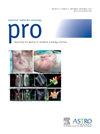WHO 4级成人弥漫性胶质瘤的放射治疗:ASTRO临床实践指南。
IF 3.5
3区 医学
Q2 ONCOLOGY
引用次数: 0
摘要
目的:中枢神经系统世界卫生组织(WHO)分级4级成人型弥漫性胶质瘤是最具侵袭性和挑战性的原发性脑肿瘤之一。本指南旨在为这些肿瘤的多学科治疗提供循证建议,重点关注诊断、初始治疗、再照射和健康差异,同时承认目前的文献主要代表历史组织学级别为4级的胶质母细胞瘤。方法:美国放射肿瘤学学会召集了一个工作组来解决4个关键问题,重点是放射治疗(RT)和/或辅助治疗(如全身治疗、交变电场治疗)的适应症,初始活检/切除后外部束RT的适当方案,包括预处理特征、靶体积、技术、剂量、再照射适应症和技术以及健康差异等变量。建议是基于系统的文献综述,并使用预定义的共识建立方法和系统来分级证据质量和建议强度。结果:在WHO 4级成人型弥漫性胶质瘤的最大安全切除、分子和病理诊断以及预后分层后,对于符合条件的患者,推荐同时RT +替莫唑胺再加辅助替莫唑胺,并有条件地推荐联合交变电场治疗。在老年患者中,有条件地推荐同时使用替莫唑胺辅助的低分割放疗。在虚弱的病人,支持和姑息治疗是有条件地推荐多学科,以病人为中心的讨论。在病理或晚期影像学证实世卫组织4级弥漫性胶质瘤复发后,可考虑并有条件地推荐适当的再照射技术,同时或不加额外的全身治疗。世卫组织4级成人型弥漫性胶质瘤患者存在健康差异,有必要注意改善结果并增加服务不足人群的临床试验入组。结论:这些基于证据的建议和目前的实践采用模式为世卫组织4级成人型弥漫性胶质瘤的管理提供了最佳临床实践。个性化医疗、生物标志物发现和新疗法的未来进步对改善结果至关重要。整合多学科治疗和参与未来的临床试验,特别是在服务不足的人群中,对于解决世卫组织4级成人型弥漫性胶质瘤的不良结局至关重要。本文章由计算机程序翻译,如有差异,请以英文原文为准。
Radiation Therapy for WHO Grade 4 Adult-Type Diffuse Glioma: An ASTRO Clinical Practice Guideline
Purpose
The central nervous system World Health Organization (WHO) grade 4 adult-type diffuse glioma represents one of the most aggressive and challenging primary brain tumors. This guideline aims to provide evidence-based recommendations for the multidisciplinary management of these tumors, focusing on diagnosis, initial treatment, reirradiation, and health disparities, while acknowledging that present literature primarily represents historical histologic grade 4 glioblastoma.
Methods
The American Society for Radiation Oncology convened a task force to address 4 key questions focused on indications for radiation therapy (RT) and/or adjunctive therapies (eg, systemic therapy, alternating electric field therapy), appropriate regimens for external beam RT after initial biopsy/resection including variables such as pretreatment characteristics, target volumes, technique, dose, reirradiation indications and techniques, and health disparities. Recommendations are based on a systematic literature review and created using a predefined consensus-building methodology and system for grading evidence quality and recommendation strength.
Results
Following maximum safe resection, molecular and pathologic diagnosis, and prognostic stratification of WHO grade 4 adult-type diffuse glioma, concurrent RT with temozolomide followed by adjuvant temozolomide is recommended for eligible patients and incorporation of alternating electric field therapy is conditionally recommended. In elderly patients, hypofractionated RT with concurrent and adjuvant temozolomide is conditionally recommended. In frail patients, supportive and palliative care is conditionally recommended following multidisciplinary, patient-centered discussion. Appropriate reirradiation techniques, with or without additional systemic therapies, can be considered and are conditionally recommended in patients following pathologic or advanced imaging confirmation of WHO grade 4 diffuse glioma recurrence. Health disparities exist in patients with WHO grade 4 adult-type diffuse glioma and attention is necessary to improve outcomes and increase clinical trial enrollment for underserved populations.
Conclusions
These evidence-based recommendations and current practice adoption patterns inform best clinical practices on the management of WHO grade 4 adult-type diffuse glioma. Future advancements in personalized medicine, biomarker discovery, and novel therapies are essential to improving outcomes. The integration of multidisciplinary care and participation in future clinical trials, especially in underserved populations, is crucial in addressing the poor outcomes among WHO grade 4 adult-type diffuse glioma.
求助全文
通过发布文献求助,成功后即可免费获取论文全文。
去求助
来源期刊

Practical Radiation Oncology
Medicine-Radiology, Nuclear Medicine and Imaging
CiteScore
5.20
自引率
6.10%
发文量
177
审稿时长
34 days
期刊介绍:
The overarching mission of Practical Radiation Oncology is to improve the quality of radiation oncology practice. PRO''s purpose is to document the state of current practice, providing background for those in training and continuing education for practitioners, through discussion and illustration of new techniques, evaluation of current practices, and publication of case reports. PRO strives to provide its readers content that emphasizes knowledge "with a purpose." The content of PRO includes:
Original articles focusing on patient safety, quality measurement, or quality improvement initiatives
Original articles focusing on imaging, contouring, target delineation, simulation, treatment planning, immobilization, organ motion, and other practical issues
ASTRO guidelines, position papers, and consensus statements
Essays that highlight enriching personal experiences in caring for cancer patients and their families.
 求助内容:
求助内容: 应助结果提醒方式:
应助结果提醒方式:


